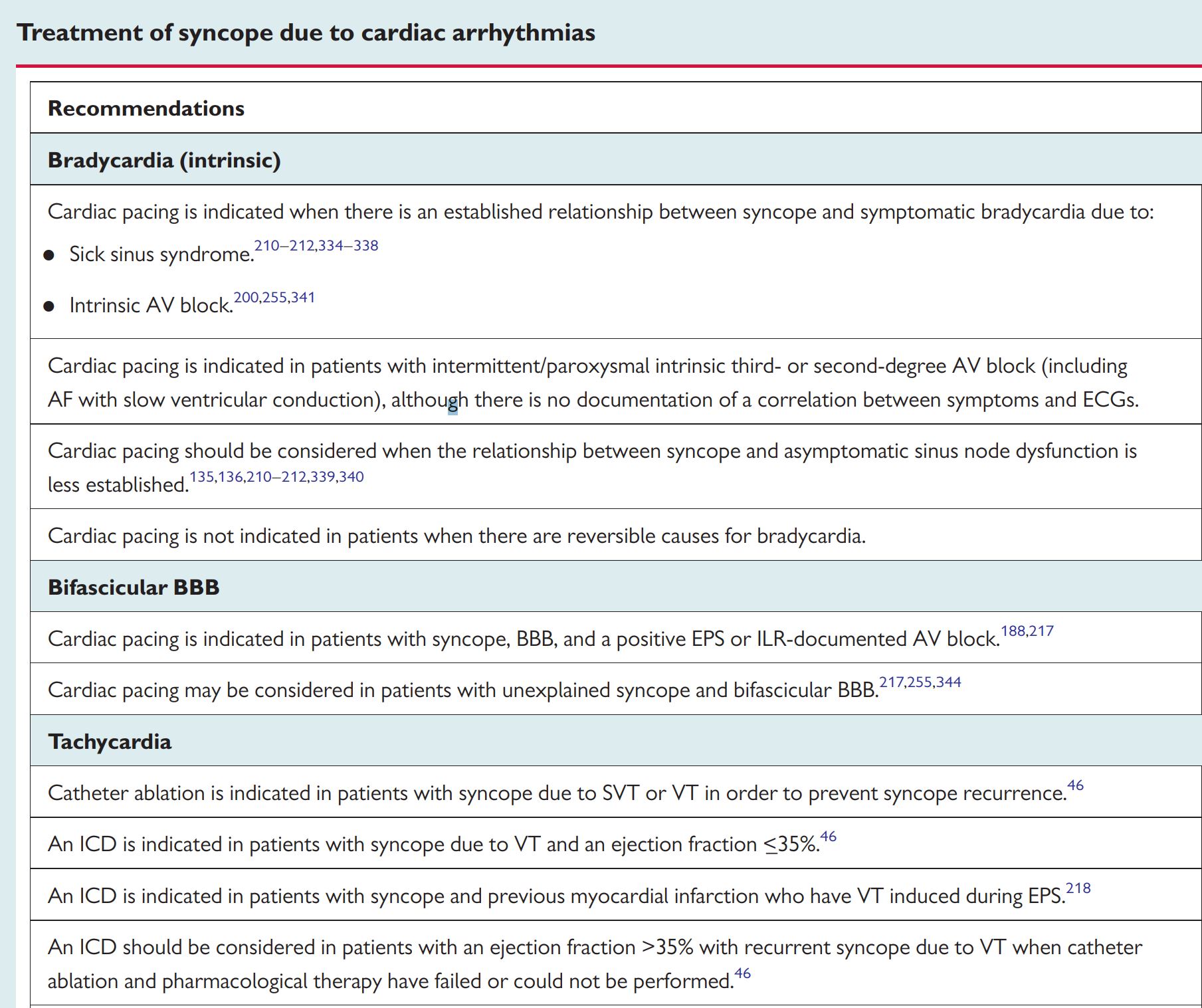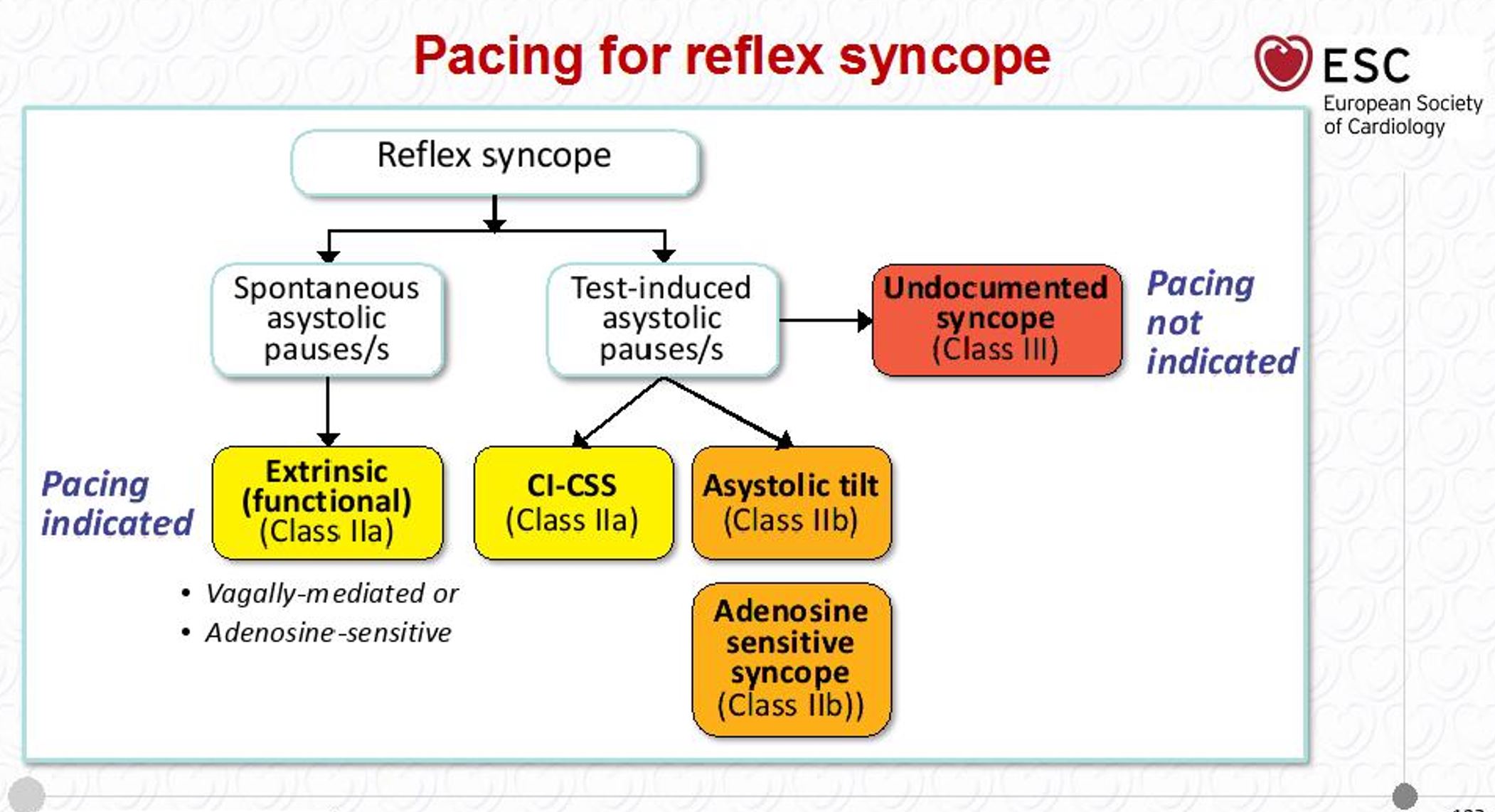Paroxysmal AV block Cardiac Pacing: Difference between revisions
Jump to navigation
Jump to search
No edit summary |
No edit summary |
||
| Line 1: | Line 1: | ||
==European Society of Cardiology : Indications for Cardiac Pacing== | |||
[[Image: Cardiac Pacing Indications.JPG|thumb|center|500px|Indications-{{cite web |url=https://www.escardio.org/Guidelines/Clinical-Practice-Guidelines/Syncope-Guidelines-on-Diagnosis-and-Management-of |title=ESC Guidelines on Syncope (Diagnosis and Management of) |format= |work= |accessdate=}}]] | [[Image: Cardiac Pacing Indications.JPG|thumb|center|500px|Indications-{{cite web |url=https://www.escardio.org/Guidelines/Clinical-Practice-Guidelines/Syncope-Guidelines-on-Diagnosis-and-Management-of |title=ESC Guidelines on Syncope (Diagnosis and Management of) |format= |work= |accessdate=}}]] | ||
| Line 22: | Line 22: | ||
[[Image:Pacing in Reflex Syncope.JPG|thumb|center|500px|Pacing in Reflex Syncope-{{cite web |url=https://www.escardio.org/Guidelines/Clinical-Practice-Guidelines/Syncope-Guidelines-on-Diagnosis-and-Management-of |title=ESC Guidelines on Syncope (Diagnosis and Management of) |format= |work= |accessdate=}}]] | [[Image:Pacing in Reflex Syncope.JPG|thumb|center|500px|Pacing in Reflex Syncope-{{cite web |url=https://www.escardio.org/Guidelines/Clinical-Practice-Guidelines/Syncope-Guidelines-on-Diagnosis-and-Management-of |title=ESC Guidelines on Syncope (Diagnosis and Management of) |format= |work= |accessdate=}}]] | ||
==2018 ACC/AHA/HRS Guideline on the Evaluation and Management of Patients With Bradycardia and Cardiac Conduction Delay: Recommendations for Temporary pacing== | |||
{|class="wikitable" | |||
|- | |||
| colspan="1" style="text-align:center; background: LemonChiffon"|[[2018 ACC/AHA/HRS Guideline on the Evaluation and Management of Patients With Bradycardia and Cardiac Conduction Delay| Recommendations for Temporary Pacing for Bradycardia Attributable to Atrioventricular Block]] | |||
|- | |||
| bgcolor="LemonChiffon"|<nowiki>"</nowiki>'''1.''' For patients with second-degree or third-degree atrioventricular block associated with symptoms or hemodynamic compromise that | |||
is refractory to medical therapy, temporary transvenous pacing is reasonable to increase heart rate and improve symptoms. ''([[ACC AHA Guidelines Classification Scheme#Level of Evidence|Level of Evidence: B-NR]]<ref name="pmid30412710">{{cite journal| author=Kusumoto FM, Schoenfeld MH, Barrett C, Edgerton JR, Ellenbogen KA, Gold MR | display-authors=etal| title=2018 ACC/AHA/HRS Guideline on the Evaluation and Management of Patients With Bradycardia and Cardiac Conduction Delay: Executive Summary: A Report of the American College of Cardiology/American Heart Association Task Force on Clinical Practice Guidelines, and the Heart Rhythm Society. | journal=J Am Coll Cardiol | year= 2019 | volume= 74 | issue= 7 | pages= 932-987 | pmid=30412710 | doi=10.1016/j.jacc.2018.10.043 | pmc= | url=https://www.ncbi.nlm.nih.gov/entrez/eutils/elink.fcgi?dbfrom=pubmed&tool=sumsearch.org/cite&retmode=ref&cmd=prlinks&id=30412710 }} </ref>'' | |||
'''2.'''For patients who require prolonged temporary transvenous pacing, it is reasonable to choose an externalized permanent active fixation lead over a standard passive fixation temporary pacing lead.''([[ACC AHA Guidelines Classification Scheme#Level of Evidence|Level of Evidence: B-NR]])<ref name="pmid30412710">{{cite journal| author=Kusumoto FM, Schoenfeld MH, Barrett C, Edgerton JR, Ellenbogen KA, Gold MR | display-authors=etal| title=2018 ACC/AHA/HRS Guideline on the Evaluation and Management of Patients With Bradycardia and Cardiac Conduction Delay: Executive Summary: A Report of the American College of Cardiology/American Heart Association Task Force on Clinical Practice Guidelines, and the Heart Rhythm Society. | journal=J Am Coll Cardiol | year= 2019 | volume= 74 | issue= 7 | pages= 932-987 | pmid=30412710 | doi=10.1016/j.jacc.2018.10.043 | pmc= | url=https://www.ncbi.nlm.nih.gov/entrez/eutils/elink.fcgi?dbfrom=pubmed&tool=sumsearch.org/cite&retmode=ref&cmd=prlinks&id=30412710 }} </ref>'' | |||
'''3.''' For patients with second-degree or third-degree atrioventricular block and hemodynamic compromise refractory to antibradycardic medical therapy, temporary transcutaneous | |||
pacing may be considered until a temporary transvenous or PPM is placed or the bradyarrhythmia resolves.''([[ACC AHA Guidelines Classification Scheme#Level of Evidence|Level of Evidence: B-R]])<ref name="pmid30412710">{{cite journal| author=Kusumoto FM, Schoenfeld MH, Barrett C, Edgerton JR, Ellenbogen KA, Gold MR | display-authors=etal| title=2018 ACC/AHA/HRS Guideline on the Evaluation and Management of Patients With Bradycardia and Cardiac Conduction Delay: Executive Summary: A Report of the American College of Cardiology/American Heart Association Task Force on Clinical Practice Guidelines, and the Heart Rhythm Society. | journal=J Am Coll Cardiol | year= 2019 | volume= 74 | issue= 7 | pages= 932-987 | pmid=30412710 | doi=10.1016/j.jacc.2018.10.043 | pmc= | url=https://www.ncbi.nlm.nih.gov/entrez/eutils/elink.fcgi?dbfrom=pubmed&tool=sumsearch.org/cite&retmode=ref&cmd=prlinks&id=30412710 }} </ref>'' <nowiki>"</nowiki> | |||
|} | |||
*The cause of atrioventricular block must be taken into account when considering the timing and necessity of temporary pacing. For example, in the setting of an MI,initial focus on primary reperfusion rather than temporary pacing for rate support may be associated with improved outcomes. | |||
*The safety of prolonged temporary pacing with an externalized active fixation permanent pacing lead has been demonstrated over the past 10 years. | |||
*Temporary transvenous pacing should therefore be used for the minimum duration necessary to provide hemodynamic support or back-up pacing to prevent asystole and should be placed by the most experienced available operator. | |||
*If atrioventricular block is felt to be irreversible, and the means to place a permanent pacing system is available, it may be best for the patient to avoid temporary pacing and proceed directly to permanent system implantation. | |||
*Use of an active fixation permanent pacing lead externalized and connected to a reusable PPM generator (sometimes referred to as a “temporary PPM”) has been introduced as a means of allowing more prolonged temporary pacing for pacemaker-dependent patients who have a contraindication to PPM implantation, such as infection. | |||
*A primary use is for bridging therapy in patients who have undergone CIED extraction for infection and require prolonged antibiotic treatment. | |||
*Patients receiving long-term antibiotics who will be receiving a new pacemaker benefit from externalized devices during the course of therapy. | |||
*Other advantages include ability to mobilize patients who would otherwise be confined to bedrest in an intensive care unit setting. | |||
*No infections have been reported with the use of reusable sterilized pacemakers. | |||
Revision as of 19:27, 27 June 2020
European Society of Cardiology : Indications for Cardiac Pacing

- The major factors predicting the efficacy of pacing in preventing syncope recurrence are an established relationship between symptoms and bradycardia and the absence of associated hypotensive susceptibility .
- When this relationship is less established, or some hypotensive mechanism is present, syncope can recur in a minority of patients.
- Pacing is not indicated in unexplained syncope without evidence of any conduction disturbance.
- Less than half of the patients with bifascicular BBB and syncope have a final diagnosis of cardiac syncope, albeit the probability is different among the types of BBB.
- Elderly patients with bifascicular BBB and unexplained syncope after a reasonable workup might benefit from empirical pacemaker implantation,especially if syncope is unpredictable (with no or short prodromes) or has occurred in the supine position or during effort. "ESC Guidelines on Syncope (Diagnosis and Management of)".
- Milena et al conducted a 4 year study to study the efficacy of cardiac pacing in patients with documented paroxysmal AV block.
- The endpoints of the study focused on syncope recurrence and time taken till first recurrence of presyncope.
- Recurrence was only seen in patients without structural heart disease and the mechanism was related to hypotension, onset of atrial fibrillation or reflex mediated.
- Significantly lower recurrence rates were seen in patients with documented paroxysmal AV block and it was also concluded that cardiac pacing could be offered more confidently to patients with structural heart disease."Syncope in patients paced for atrioventricular block. | Semantic Scholar".
- The Syncope Unit Project -2 (SUP-2 ) studied carried about by Brignole et al included patients with a history of recurrent syncope and positive findings on carotid sinus massage/ tilt table testing/ implantable loop recorders.
- Such patients were fitted with dual chamber pacemakers and recurrence rates were followed up.
- Using a standardized algorithm in their approach, they came to the conclusion that pacing can be can be offered to patients with positive findings on carotid sinus massage/ tilt table testing/ implantable loop recorders.
- An efficacy of 3 years was maintained. [1]
- Furthermore, similar results were also found in those with intrinsic AV block patients and in tilt table positive asystolic reflex syncope patients.
- The ISSUE 3 study also produced similar results where TT- negative asystolic reflex syncope patients were concerned. [2]

2018 ACC/AHA/HRS Guideline on the Evaluation and Management of Patients With Bradycardia and Cardiac Conduction Delay: Recommendations for Temporary pacing
| Recommendations for Temporary Pacing for Bradycardia Attributable to Atrioventricular Block |
| "1. For patients with second-degree or third-degree atrioventricular block associated with symptoms or hemodynamic compromise that
is refractory to medical therapy, temporary transvenous pacing is reasonable to increase heart rate and improve symptoms. (Level of Evidence: B-NR[3] 2.For patients who require prolonged temporary transvenous pacing, it is reasonable to choose an externalized permanent active fixation lead over a standard passive fixation temporary pacing lead.(Level of Evidence: B-NR)[3] 3. For patients with second-degree or third-degree atrioventricular block and hemodynamic compromise refractory to antibradycardic medical therapy, temporary transcutaneous pacing may be considered until a temporary transvenous or PPM is placed or the bradyarrhythmia resolves.(Level of Evidence: B-R)[3] " |
- The cause of atrioventricular block must be taken into account when considering the timing and necessity of temporary pacing. For example, in the setting of an MI,initial focus on primary reperfusion rather than temporary pacing for rate support may be associated with improved outcomes.
- The safety of prolonged temporary pacing with an externalized active fixation permanent pacing lead has been demonstrated over the past 10 years.
- Temporary transvenous pacing should therefore be used for the minimum duration necessary to provide hemodynamic support or back-up pacing to prevent asystole and should be placed by the most experienced available operator.
- If atrioventricular block is felt to be irreversible, and the means to place a permanent pacing system is available, it may be best for the patient to avoid temporary pacing and proceed directly to permanent system implantation.
- Use of an active fixation permanent pacing lead externalized and connected to a reusable PPM generator (sometimes referred to as a “temporary PPM”) has been introduced as a means of allowing more prolonged temporary pacing for pacemaker-dependent patients who have a contraindication to PPM implantation, such as infection.
- A primary use is for bridging therapy in patients who have undergone CIED extraction for infection and require prolonged antibiotic treatment.
- Patients receiving long-term antibiotics who will be receiving a new pacemaker benefit from externalized devices during the course of therapy.
- Other advantages include ability to mobilize patients who would otherwise be confined to bedrest in an intensive care unit setting.
- No infections have been reported with the use of reusable sterilized pacemakers.
- ↑ Brignole M, Arabia F, Ammirati F, Tomaino M, Quartieri F, Rafanelli M; et al. (2016). "Standardized algorithm for cardiac pacing in older patients affected by severe unpredictable reflex syncope: 3-year insights from the Syncope Unit Project 2 (SUP 2) study". Europace. 18 (9): 1427–33. doi:10.1093/europace/euv343. PMID 26612880.
- ↑ Brignole M, Menozzi C, Moya A, Andresen D, Blanc JJ, Krahn AD; et al. (2012). "Pacemaker therapy in patients with neurally mediated syncope and documented asystole: Third International Study on Syncope of Uncertain Etiology (ISSUE-3): a randomized trial". Circulation. 125 (21): 2566–71. doi:10.1161/CIRCULATIONAHA.111.082313. PMID 22565936.
- ↑ 3.0 3.1 3.2 Kusumoto FM, Schoenfeld MH, Barrett C, Edgerton JR, Ellenbogen KA, Gold MR; et al. (2019). "2018 ACC/AHA/HRS Guideline on the Evaluation and Management of Patients With Bradycardia and Cardiac Conduction Delay: Executive Summary: A Report of the American College of Cardiology/American Heart Association Task Force on Clinical Practice Guidelines, and the Heart Rhythm Society". J Am Coll Cardiol. 74 (7): 932–987. doi:10.1016/j.jacc.2018.10.043. PMID 30412710.